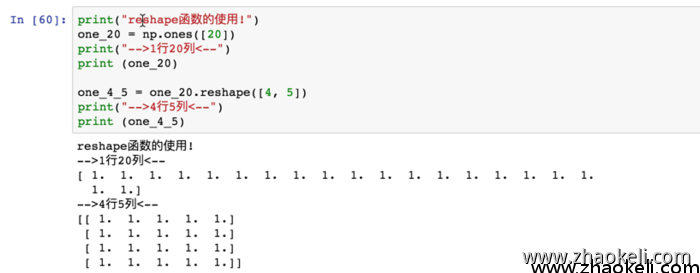机器学习Numpy的基本用法 【转】
版权声明:
本文为博主学习过程中整理发布,如有侵权请告知
更新时间:
2018-06-10 14:04:08
温馨提示:
学无止境,技术类文章有它的时效性,请留意文章更新时间,如发现内容有误请留言指出,防止别人"踩坑",我会及时更新文章
Numpy简单创建数组
import numpy as np # 创建简单的列表 a = [1, 2, 3, 4] # 将列表转换为数组 b = np.array(b)
Numpy查看数组属性
数组元素个数
b.size
数组形状
b.shape
数组维度
b.ndim
数组元素类型
b.dtype
快速创建N维数组的api函数
创建10行10列的数值为浮点1的矩阵
array_one = np.ones([10, 10])
创建10行10列的数值为浮点0的矩阵
array_zero = np.zeros([10, 10])
从现有的数据创建数组
array(深拷贝)
asarray(浅拷贝)
Numpy创建随机数组np.random
均匀分布
np.random.rand(10, 10)创建指定形状(示例为10行10列)的数组(范围在0至1之间)np.random.uniform(0, 100)创建指定范围内的一个数np.random.randint(0, 100)创建指定范围内的一个整数正态分布
给定均值/标准差/维度的正态分布
np.random.normal(1.75, 0.1, (2, 3))
数组的索引, 切片
# 正态生成4行5列的二维数组arr = np.random.normal(1.75, 0.1, (4, 5)) print(arr)# 截取第1至2行的第2至3列(从第0行算起)after_arr = arr[1:3, 2:4] print(after_arr)
数组索引
改变数组形状(要求前后元素个数匹配)
改变数组形状
print("reshape函数的使用!")
one_20 = np.ones([20])
print("-->1行20列<--")print (one_20)
one_4_5 = one_20.reshape([4, 5])
print("-->4行5列<--")print (one_4_5)Numpy计算(重要)
条件运算
原始数据
条件判断
import numpy as np stus_score = np.array([[80, 88], [82, 81], [84, 75], [86, 83], [75, 81]]) stus_score > 80
三目运算
import numpy as np stus_score = np.array([[80, 88], [82, 81], [84, 75], [86, 83], [75, 81]]) np.where(stus_score < 80, 0, 90)
统计运算
指定轴最大值
amax(参数1: 数组; 参数2: axis=0/1; 0表示列1表示行)
求最大值
stus_score = np.array([[80, 88], [82, 81], [84, 75], [86, 83], [75, 81]])# 求每一列的最大值(0表示列)print("每一列的最大值为:")
result = np.amax(stus_score, axis=0)
print(result)
print("每一行的最大值为:")
result = np.amax(stus_score, axis=1)
print(result)指定轴最小值
amin
求最小值
stus_score = np.array([[80, 88], [82, 81], [84, 75], [86, 83], [75, 81]])# 求每一行的最小值(0表示列)print("每一列的最小值为:")
result = np.amin(stus_score, axis=0)
print(result)# 求每一行的最小值(1表示行)print("每一行的最小值为:")
result = np.amin(stus_score, axis=1)
print(result)指定轴平均值
mean
求平均值
stus_score = np.array([[80, 88], [82, 81], [84, 75], [86, 83], [75, 81]])# 求每一行的平均值(0表示列)print("每一列的平均值:")
result = np.mean(stus_score, axis=0)
print(result)# 求每一行的平均值(1表示行)print("每一行的平均值:")
result = np.mean(stus_score, axis=1)
print(result)方差
std
求方差
stus_score = np.array([[80, 88], [82, 81], [84, 75], [86, 83], [75, 81]])# 求每一行的方差(0表示列)print("每一列的方差:")
result = np.std(stus_score, axis=0)
print(result)# 求每一行的方差(1表示行)print("每一行的方差:")
result = np.std(stus_score, axis=1)
print(result)数组运算
数组与数的运算
加法
stus_score = np.array([[80, 88], [82, 81], [84, 75], [86, 83], [75, 81]])
print("加分前:")
print(stus_score)# 为所有平时成绩都加5分stus_score[:, 0] = stus_score[:, 0]+5print("加分后:")
print(stus_score)
乘法
stus_score = np.array([[80, 88], [82, 81], [84, 75], [86, 83], [75, 81]])
print("减半前:")
print(stus_score)# 平时成绩减半stus_score[:, 0] = stus_score[:, 0]*0.5print("减半后:")
print(stus_score)数组间也支持加减乘除运算,但基本用不到
image.png
a = np.array([1, 2, 3, 4])
b = np.array([10, 20, 30, 40])
c = a + b
d = a - b
e = a * b
f = a / b
print("a+b为", c)
print("a-b为", d)
print("a*b为", e)
print("a/b为", f)矩阵运算np.dot()(非常重要)
根据权重计算成绩
计算规则
(M行, N列) * (N行, Z列) = (M行, Z列)
矩阵计算总成绩
stus_score = np.array([[80, 88], [82, 81], [84, 75], [86, 83], [75, 81]])# 平时成绩占40% 期末成绩占60%, 计算结果q = np.array([[0.4], [0.6]])
result = np.dot(stus_score, q)
print("最终结果为:")
print(result)矩阵拼接
矩阵垂直拼接
垂直拼接
print("v1为:")
v1 = [[0, 1, 2, 3, 4, 5],
[6, 7, 8, 9, 10, 11]]
print(v1)
print("v2为:")
v2 = [[12, 13, 14, 15, 16, 17],
[18, 19, 20, 21, 22, 23]]
print(v2)# 垂直拼接result = np.vstack((v1, v2))
print("v1和v2垂直拼接的结果为")
print(result)矩阵水平拼接
水平拼接
print("v1为:")
v1 = [[0, 1, 2, 3, 4, 5],
[6, 7, 8, 9, 10, 11]]
print(v1)
print("v2为:")
v2 = [[12, 13, 14, 15, 16, 17],
[18, 19, 20, 21, 22, 23]]
print(v2)# 垂直拼接result = np.hstack((v1, v2))
print("v1和v2水平拼接的结果为")
print(result)Numpy读取数据np.genfromtxt
csv文件以逗号分隔数据
读取csv格式的文件
如果数值据有无法识别的值出现,会以
nan显示,nan相当于np.nan,为float类型.






















